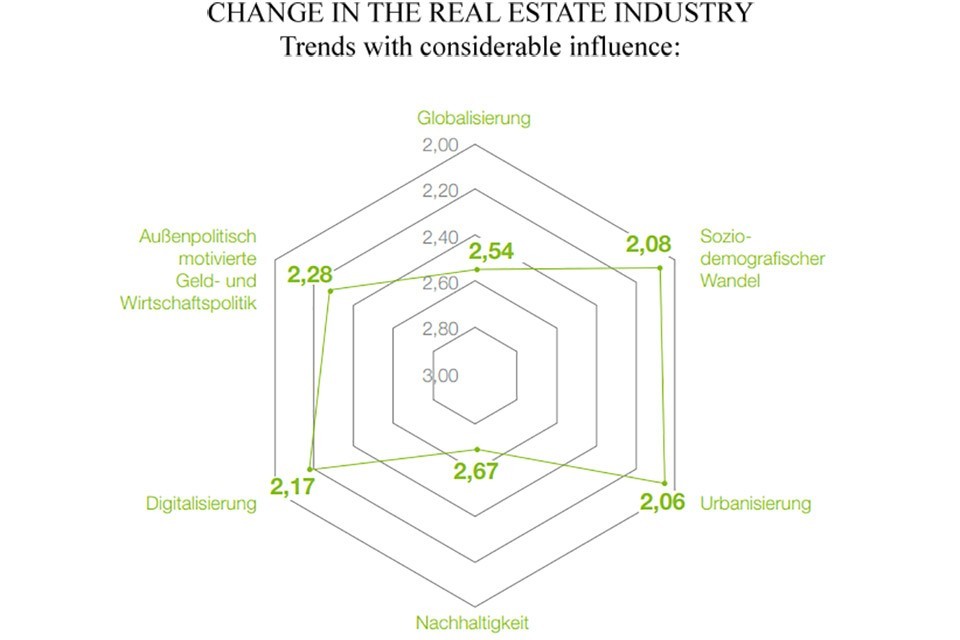Study: Change in the real estate industry

As part of an empirical research project, the “Real Estate Economics and Construction Economics” department of the Research Centre for Corporate Real Estate Economics (FBI) at Darmstadt Technical University, in cooperation with Helaba’s subsidiary OFB (Project Development, Project Management and Real Estate Management), investigated the effects of transformation through digitisation and structural change – in conjunction with economic and social structural change – on the real estate industry.
The aim of the 12-month project was to understand the impact of structural change on companies in the construction and real estate industries and to identify the need to adapt existing business models, products and processes.
Big picture of the transformation
In the real estate industry, one speaks of digitization and structural change – the topic seems to have arrived in the industry. If, however, one asks the players where there is a need for action, there are usually no concrete answers. In view of the numerous fragmented market analyses and technology building blocks, there is a growing danger of losing sight of the essentials of transformation and leaving the effective adjustment path of the real estate industry behind for companies. The aim of the project was therefore to systematise the drivers of this structural change – and to show what pressure the individual players in the real estate industry will be exposed to.
Structural change in the real estate sector –
more than digitalization
Following the study results on trends and structural change drivers, the researchers believe that the real estate industry is facing a far-reaching transformation process. According to the surveyed decision-makers, the strongest influence on the real estate industry comes from urbanization and socio-demographic change. These trends should have a significant and lasting influence on demand and supply structures within the real estate markets.
Structural change will continue to intensify
From the results of the study it is clear that the structural change in the real estate industry with its processes of change in the value creation system is still to come for many actors in the real estate industry. The majority of the respondents see the influence of structural change on their company increasing massively over the next 5 years. The construction and real estate industries would then face a similar transformation challenge in the future as many other important economic sectors – such as the automotive sector or financial service providers.
Transformation offers opportunities
With regard to other sectors, it is astonishing how comparatively little the real estate players make use of the competitive opportunities that present themselves, in particular globalisation, urbanisation and digitisation. The majority of real estate players may miss an opportunity here. The results of the study also suggested that companies underestimated the risks posed by new market participants or changes in user requirements as a result of structural change to their existing business model.
The results also suggested that almost every second real estate industry player currently lacks the necessary time and/or suitable personnel to identify or even implement necessary corporate changes and thus adaptation strategies in the transformation process.
Driving force: Real estate users
The study results make it clear that structural change is being carried into the real estate industry by changing the space and service requirements of users from other sectors. Users are not only strongly sensitised to structural change issues, but are also most affected among all groups of actors. They rated the structural change that had already taken place in the last five years by far the most serious.
According to user estimates, the pressure of structural change on the real estate industry will continue to increase massively in the future.
For the users surveyed, the optimisation of the flexibility of real estate is at the centre of the adaptation of the real estate industry to structural change. According to the interviewees, multifunctional and flexibly usable buildings in particular are contributing to the creation of flexibility. In addition, the study results should also show a growing demand for holistic solutions in the provision of real estate. These holistic solutions primarily relate to services from a single source – but also to flexible forms of real estate provision.
Project developers required as solution providers
After the users, the project developers rated the influence of the above-mentioned trends on the real estate industry the highest. They are not only sensitized accordingly, but also affected in their daily work and expect the strongest increase in the influence of structural change on their business model over the next 5 years. As a reaction to structural change, multifunctional real estate, revitalization of existing buildings and intelligent buildings with building automation should gain in importance for project developers.
Following the changing needs of users, almost two thirds of those surveyed considered integrated services to be forward-looking. Almost half of the project developers surveyed focused in particular on operator models when adapting their business models. Obviously, own operator models as well as cooperations with operators with market experience are considered as a strategy.
In the course of structural change, project developers should increasingly find themselves in the role of solution providers due to their position between users and the capital market. In the future, the success of a project developer will depend even more on the extent to which it is able to supply both real estate users and real estate investors with products that jointly meet their requirements.
The complete study and further information can be found at the following URLs if you are interested:
Study: Transformation of the real estate industry
Digitization in the real estate industry
FBI
Lemonbeat
OFB
TU Darmstadt











